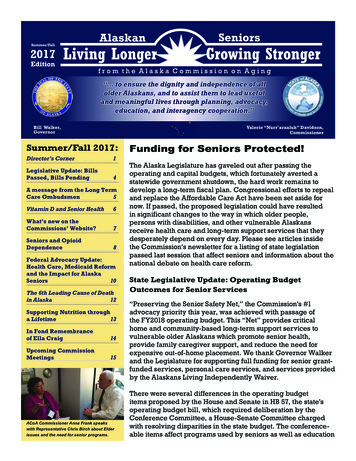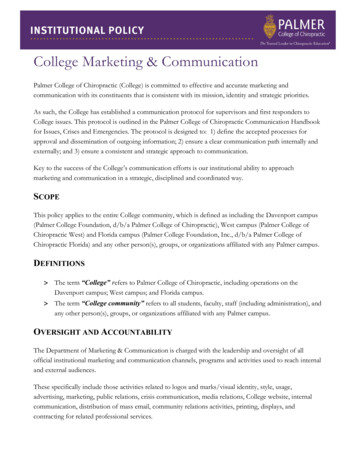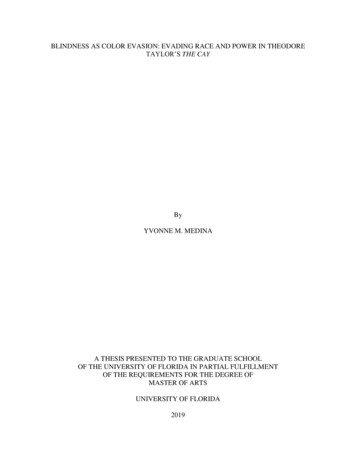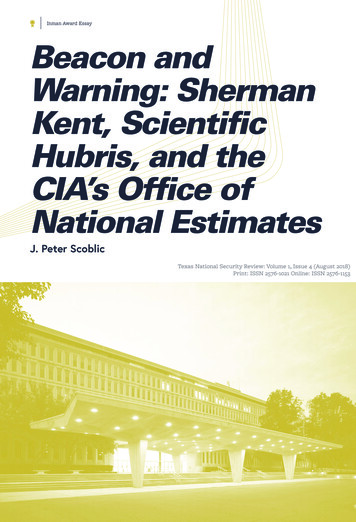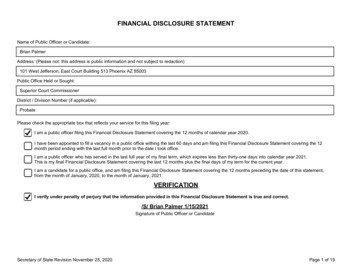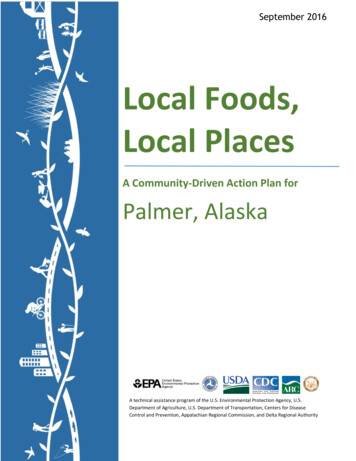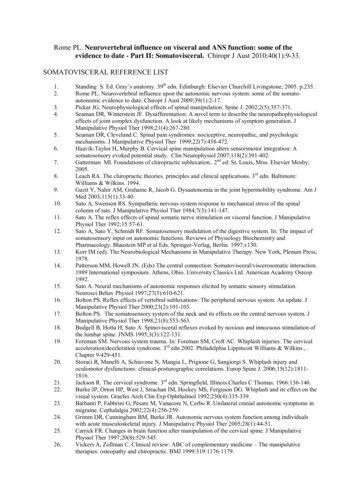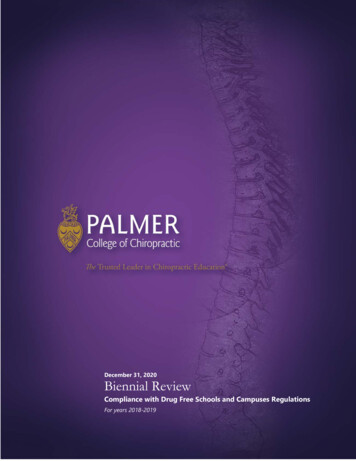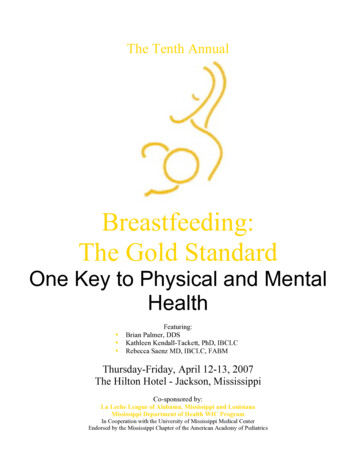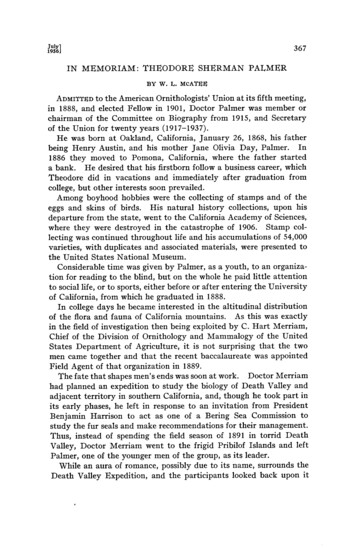
Transcription
Suyq3671956JINMEMORIAM:THEODORESHERMANPALMERBY W. L. McATEEADMITTEDto the American Ornithologists'Union at its fifth meeting,in 1888, and elected Fellow in 1901, Doctor Palmer was member orchairman of the Committee on Biography from 1915, and Secretaryof the Union for twenty years (1917-1937).He was born at Oakland, California, January 26, 1868, his fatherbeing Henry Austin, and his mother Jane Olivia Day, Palmer. In1886 they moved to Pomona, California, where the father starteda bank.He desired that his firstborn follow a business career, whichTheodore did in vacations and immediately after graduation fromcollege,but other interestssoonprevailed.Amongboyhoodhobbieswere the collectingof stampsand of theeggsand skins of birds. His natural history collections,upon hisdeparturefrom the state, went to the CaliforniaAcademyof Sciences,where they were destroyedin the catastropheof 1906. Stamp collectingwas continuedthroughoutlife and his accumulationsof 54,000varieties, with duplicatesand associatedmaterials,were presentedtothe UnitedStates NationalMuseum.Considerabletime wasgivenby Palmer,as a youth, to an organization for readingto the blind, but on the wholehe paid little attentionto sociallife, or to sports,eitherbeforeor after enteringthe Universityof California, from which he graduated in 1888.In collegedayshe becameinterestedin the altitudinaldistributionof the flora and fauna of California mountains. As this was exactlyin the field of investigationthen beingexploitedby C. Hart Merriam,Chief of the Division of Ornithologyand Mammalogy of the UnitedStates Departmentof Agriculture,it is not surprisingthat the twomen cametogetherand that the recent baccalaureatewas appointedField Agent of that organizationin 1889.The fate that shapesmen'sendswassoonat work. DoctorMerriamhad plannedan expeditionto study the biologyof Death Valley andadjacentterritory in southernCalifornia,and, thoughhe took part inits early phases,he left in responseto an invitationfrom PresidentBenjamin Harrison to act as one of a Bering Sea Commissiontostudy the fur sealsand makerecommendationsfor their management.Thus, insteadof spendingthe field seasonof 1891 in torrid DeathValley, Doctor Merriam went to the frigid Pribilof Islandsand leftPalmer,one of the youngermen of the group,as its leader.While an aura of romance,possiblydue to its name,surroundstheDeath Valley Expedition,and the participantslookedback uponit
PLATETi E Au :, VoL. 7315Blackstone Studios54West57th StreetNew YorkT ODOR S RMANPALMER
368McAT , TheodoreShermanPalmer[ Auk[Vol.as their great adventure, reporting upon it was disjointed and wasnever completed. Four of eight authors of chaptersin the mainpublishedreport (North AmericanFauna, No. 7, 1893) were not onthe Expedition; the botany was treated in a Contribution from theNational Herbarium; and no general account of the mammals has everappeared. The Fauna referred to is labelled Part II; and Part I,postponedindefinitely, apparently is representedonly by two papersprivately printed at Washington by Doctor Palmer in 1952. Theseare: "Place Names of the Death Valley Region in California andNevada" (80 pp.), and "Chronologyof the Death Valley RegioninCalifornia, 1849-1949" (25 pp.). These were edited by DoctorPalmer from material suppliedby himself, by two historiansin theLibrary of Congress,and by three employesof the Death ValleyNational Monument. Through the years he collectedeverything hecould find relating to Death Valley--books, maps, manuscripts-doubtlessthe most complete assemblageof its kind, and this he bequeathed to the Henry E. Huntingto Library at San Marino,California.Doctor Palmer was a lifelong, and an ardent, book collector andgot togethera fine library, particularly rich in setsof scientificperiodicals, that filled to over-flowing three rooms in his residence. Thiswas willed to the University of California, with transportation paidfrom Washingtonto Berkeley. He not only collectedvariously butin the end it proved to very goodpurposes.But to get back to his career: by the year 1892, the reports of theDeath Valley Expedition, so far as they were written at the time, hadto be done. The World's Columbian Exposition at Chicago wascoming on and the Department of Agriculture prepared exhibitsfor it on a lavish scale.Most of these were returnedafter the Fairand housed in a vast, barn-like structure on the Department ofAgriculturegrounds.Every branchof the Department wasrepresented;the exhibits must be prepared, sent to Chicago, and installed; thenafter their period of publicity, returned and re-displayedin Washington. The administrativedetail necessaryto accomplishall this wasnot to the taste of Chief Merriam and we may be sure that Palmerwas assigneda full share of the supervision,thus leading up to hisperiods of service as Assistant Chief (1896-1902 and 1910-1914).Despite other activities, the early years at Washingtongave Palmeropportunity for further education,of which he took advantage to theextent of winningan M.D. degreeat GeorgetownUniversity. Possiblythis was in emulation of Doctors Merriamand Fisher, the entireoriginal scientific staff of the organization, both of them graduates
Julyl19561McAT : :,TheodoreShermanPalmer369of the College of Physicians and Surgeonsin New York City. However that may be, Palmer never practiced medicine and apparentlyhad no idea of doing so.There was pressureon the nascent Biological Survey to makeeverything look "economic" and Palmer's share in the responsewasa bulletin on a groupof injuriousmammals,"The Jack Rabbits of theUnited States" (1896; revised 1897). By "economic" is meant inrelation to agriculture and the word was in the title of the organizationfrom the beginning in 1885 until its designation as the Division ofBiological Survey in 1896.Palmer dipped into scientificphasesof the work, describing,withE. W. Nelson, five new birds from Mexico in 1894, and contributingsome short notes on bird nomenclatureand distributionto 'The Auk.'To the most technicalseriesof the Survey'spublications--theNorthAmerican Faunas--he contributed its bulkiest number (23), of almosta thousand pages. This was the "Index Generum Mammalium,"which appearedin 1904. The beginningof it was a collectionof 250names turned over to him by Doctor Merriam in 1889. This heincreased until in 1902 it numbered around 4,500.Palmer recordsthe great assistancein the work of Miss Thora Stejneger who madethree trips to enlargeand verify the compendiumin Europeanlibraries.It does no harmto drawrenewedattentionto thatcollaborationhereand to point out that Miss Stejneger, an accomplishedlinguist, wasthe sister of Leonhard Stejneger of the National Museum. In myearliest Survey days, I saw her busied with the final stages of the"Index," answering if anyone ever did to what is conceived as atypical maiden lady--and as unobtrusive and quiet as a nun.However, Doctor Palmer's tastes led him away from establishedlines of the Survey'sprogram, and he specializedin the field of legislation affecting wildlife; developed a branch of the organization tohandle it, of which he was leader (1902-1910 and 1914-1916); andwith which he was in some way associatedduring the remainder ofhis career in the Civil Service.His flair was for compiling and summarizing basic information,and he prepared a number of publications that have never beensuperseded,as: "Extermination of noxious animals by bounties"(1897); "The danger of introducing noxious animals and birds"(1899); "Hunting licenses:Their history, objects, and limitations"(1904); "Private gamepreservesand their future in the United States"(1910); and "Chronologyand index of the more important eventsinAmerican game protection, 1776-1911" (1912).Related publicationsof this fruitful period were: "Bird day in the
370Mc A , TheodoreShermanPalmer[ AuktVol.73schools"(1896); "Legislation for the protection of birds other thangame birds" (1900); "Laws regulating the transportationand saleof game" (with Henry Oldys,1900);"A reviewof economicornithologyin the United States" (1900); "Somebenefitsthe farmer may derivefrom game protection" (1905); and "Game as a national resource"(1922).Some of these were trail-blazers, the 1899 paper on introductionsleadingto the Lacey Act of 1900,regulatingthe importation of noxiousanimals and prohibiting the transportation in interstate commerceof game killed in violation of local laws. "Bird day in the schools"was a precursorof Audubon Society activities; and directoriesofofficials and organizationsconcernedwith wildlife protection, anddigestsof gamelaws, begunin 1901and donewholly, or participatedin, by Doctor Palmer until 1915, are features of Federal conservationwork that are continuedto this day.Under Doctor Palmer's direction, but at first by his own hand, acomprehensivecollection of information on wildlife conservationwas assembledin card catalog form, upon which Henry Oldys andR. W. Williams of his Division based valuable publications, andwhich can still be mined with profit by conservationistswho arebibliographicallyinclined.Administrationkept pacewith the deftnihonof programsand underDoctor Palmer the work grewuntil it includedinspectorsat principalports of entry and roving agentsto aid in enforcingthe importationand interstate commerceclausesof the Lacey Act. In this memorialin 'The Auk,' let it not be forgottenthat the BiologicalSurvey, as awhole, and specificallyits work on the distribution, migration, andeconomicvalue of birds, as well as on bird protection, grew out ofCommittee activities of the American Ornithologists'Union.Quotingnowfrom T. Gilbert Pearson'schapteron "Bird Protection"in "Fifty Years' Progressof American Ornithology 1883-1933,"publishedby the Union in 1933, we learn that:"During the period from 1895 to 1905 the A.O.U. Committee was very active.Five of these years Witmet Stone was the Chairman, the other five William Dutcheroccupied this position. During that decade the [A.O.U.] Model Law Ifor the protection of non-gamebirds] was adoptedby 32 states. Efforts for its enactmentwerecarried on with the constant advice and closecooperationof Theodore S. Palmer.Mr. Dutcher, on more than one occasion,wrote: 'I do nothing without first consultingPalmer.'"(p. 201).This campaignamong the state legislaturesrequired a great dealof travel at first by Dutcher and Palmer and later by Palmer andPearson. Not only were songbird protection and the organization
July]19561McAT , TheodoreShermanPalmer371of local Audubon societies advanced, but efforts were made to buildmachineryto enforceprotectivelaws, as by encouragingthe establishment of state warden systems,game commissions,and conservationdepartments.Doctor Palmer was the leading authority in this field, witnessthepublications previously noted, and his advice was weighty withlegislativecommittees. Some of this work is outlined in Pearson'sbook, "Adventures in Bird Protection" (1937). With Pearson,DoctorPalmerrevivedthe NationalAssociationof StateGameandFish Wardens in 1914, and it has continued in active existence eversince,now beinginternational in scopein the Americas.Through the American Ornithologists'Union, Dr. Palmer becameacquainted with George Bird Grinnell who founded an AudubonSocietywhichlived only from 1886to 1889;and with William Dutcher,main instigator of the Associationwhich later becamethe NationalAudubon Society. The first meeting of the Board of Directors ofDutcher's project was held January 30, 1905, and Doctor Palmerwas elected Second Vice-President.In 1908 he was advancedto theFirst Vice-Presidency,in which capacity he served until 1936. Hewas elected a member of the Board of Directors in 1907, his term tobegin in 1908, and he continued on the Board also until 1936--aperiod of 28 years.At the sametime he did not neglecthis home area, helping to foundthe Audubon Society of the District of Columbia in 1897, and servingas its President, 1924-1941. Upon his retirement from that office,he was named President Emeritus and so remained throughout life.This Associationconductedbird classes for teachers in the Districtof Columbia schoolsand organizedspringbird trips for all interested-activitiesinto which employesof the BiologicalSurvey (includingthewriter) were regularly drafted. Doctor Palmer directed the indoor,and ProfessorW. W. Cooke the outdoor, programs. Mr. Irston R.Barnes, now President of the Audubon Society of the District ofColumbia, informs me that Doctor Palmer's records pertaining tothe Society have been placed in the Washington Public Library.Doctor Palmer summarized in print "Laws for the protection ofbirds and game in the District of Columbia" in 1901. He followedall District and National conservation legislation, promoting it inpublic hearingsand by personalinterviews with Senatorsand Representatives. [Congressthen, and still, is the legislative body forthe District of Columbia.] It is safe to say that he influenced allsuch legislationfrom 1900 to 1924 and in some instanceswas theprincipal factor. He wrote the preliminary draft of the treaty for
372McATEE,TheodoreShermanPalmer[ Auk[Vol.protection of birds migrating between Canada and the United States(1916); and was Chairman of the Committee [other members:A. K.Fisher; W. W. Cooke] which prepared the first regulationsunder theMigratory Bird Treaty Act (1918). He relishedsuch activities andeven after retirement he often visited congressionalofficesin supportof measures in which he was interested.This memorial has already made free use of the flashback andother is now necessaryto bring the bird sanctuary movement intofocus. In 1900 the A.O.U. Bird Protection Committee, at the suggestionof, and by meansof funds provided by, Abbott H. Thayer,began the guarding of coloniesof gulls and terns. This led to thesanctuary program of the National Audubon Society and to that ofthe Federal governmentthrough the BiologicalSurvey and its successor the Fish and WildlifeService.Pelican Island, Florida, where the birds had been slaughteredbyfishermen, was first of the Federal sanctuaries--a consummation ofefforts by Frank M. Chapman, William Dutcher, and T. S. Palmer,with essential aid from C. L. Du Bois and Frank Bond of the UnitedStates General Land Office. The facts being submitted to PresidentTheodoreRoosevelt,he issuedan Executive Order (March 14, 1903)setting apart the island "for the useof the Department of Agricultureas a preserveand breeding-groundsfor native birds."That established a precedent. Frank M. Miller recommendedsimilar treatment for Louisiana breeding colonies of sea birds.Through Bond's cooperation,it was learned that someof the islandsinvolved were government property; President Roosevelt was againappealed to; and he responded,creating by decree the Breton IslandReservation(October4, 1904). Bond, a lifelongornithologist,beingChief Clerk of the General Land Office, was in good position to collaborate in the refuge program; Doctor Palmer threw in the resourcesof the BiologicalSurvey; and William Dutcher thoseof the NationalAudubon Society; and by 1909, fifteen additional reservations forthe protection of birds were made by Executive Order. Some question aroseas to the legality of the method but Congressionalapprovalwas given by a law passedin 1906.The Hawaiian Islands Bird Reservation,severallarge areasof lakeand marsh in the public domain, as well as the reservoirsof irrigationprojectsin westernstates,were made sanctuariesin the samemanner.Whatever happened later, that was the very substantial beginningof the Federal Wildlife RefugeProgram,and Doctor Palmer was inthe thick of it.He was a man who never seemed hurried, hencewith so large an accomplishment,he must have been highly efficient.
July]1956JMc xTBB,TheodoreShermanPalmer3 73Great as were his interests in the matters thus far discussed, thatin the American Ornithologists' Union was greater. As noted in ourintroductory sentence,he was elected to the Class of Fellows in 1901,but he had already been engagedin businessof the Union, servingon the committee which, under the Chairmanship of Dr. JonathanDwight, Jr., prepared the "Index to the Bulletin of the NuttallOrnithological Club . . . 1876-1883 and to . . . The Auk . . . 1884-1900." Acknowledgment to Doctor Palmer for assistancein obtaining full names of authors reveals the biographical interest inpeoplethat was manifestedby him all his life.He was Chairmanof the Committeefor continuationof the Indexthrough two decades: 1901-1910 (published 1915) and 1911-1920(published1929). The amount of detail required from workersonsuch indexes(known only to those who have been through the mill)is justified by the usefulnessof their products. Doctor Palmerhad individual ideasfor increasingthat utility by providing completenames of authors and by accompanying each of these decennialpublications with a Biographical Index, containing references toobituaries printed in 'The Auk' and giving place and date of birthand death of the deceased. When no longer on the Index Committee,Doctor Palmer was largely instrumental in the continuation of thebiographical sectionsand for completing the names of authors. Suchassistanceis specifically acknowledgedin the Indexes for 1921-1930(H. S. Swarth, 1934)and 1931-1940(GeorgeWillett, 1941).Doctor Palmer was ever interested in keeping up to date the list ofdeceasedmembers of the A.O.IJ. and summarizes its history in the"Biographical index and list of deceased members of the AmericanOrnithologists' Union" as follows:"The first list of members of the American Ornithologists' Union appeared in'The Auk' for 1886 and contained the name of one deceasedmember. During thenext five years names of deceasedmembers were marked merely by an asterisk butin 1892 they were first brought together in a separatelist with the dates of death.This arrangementwas followeduntil 1920and sincethen the list has been publishedonly at intervals of five years. In 1930, a further change was made by includingreferences to obituary notices thus converting the list into a biographical index."The last complete list, which appeared in July 1940, contained more than 750names and references to biographies of about 550 individuals. In 1945 the listincluded only additions subsequentto 1940. The present list contains 1055 namesand referencesto biographiesof 839 individuals."This index is dated 1950 and appearsto have been privately printedby Doctor Palmer. It is paged v-xxiii and was distributed with thefollowing note: "Recipients are requestedto remove the coversandinsert the List in 'The Auk' for 1950, immediately after the intro-
374McAT , TheodoreShermanPalmer[ AukœVol.?sduetory pages following the title page." As Secretary, he was forfrequent issueof the list of membersand would have had it annuallyexcept for the objectionsof Editors of 'The Auk' to so much beingspent in that, to their minds, barren direction. However, the listof membersis a very useful thing, and in this writer's opinion shouldbe publishedat no longer than five-year intervals. From his experienceas Treasurer(1920-1938) he knowsthat the overturnin addressescan be theoretically completein a lustrum, the annual rate of changebeing about 20 to 25 per cent.It was characteristicof DoctorPalmer to wait until he was in controlof a job, then to pitch into it intensively and shapeit as his own. Soit was with the two Index Chairmanships and with the Committeeon Biography and Bibliography; and so it was with the Secretaryshipof the Union. He loved the ritual of the position at the annualmeetings; the precise order of business,the calling of the roll; and,as well, the opportunity to take part in discussionof papers,motions,and resolutions; and to comment on the history of a situation, in asonorousvoice of someoratorical power.He studied the classesof membership,doubtlessto educatehimselffor the job, but he gave the results in short articles in 'The Auk.'He wrote also on the geographical distribution of members, on theCheck-Lists, on indexes to ornithological literature, full names ofauthors, and attendance at meetings; and from time to time presented lists of all meetings of the Union. Probably his banker'straining led him to take special interest in the permanent funds ofthe Union and to push the development of a Board of InvestingTrustees to handle them. He was especiallykeen on the establishment of funds for researchand was active in promotingfree membership for promising students and for those in the Armed Forces inwartime. He worked hard to increase the number of completesetsof 'The Auk' in libraries and reported the resultsin four differentpapersin 'The Auk' (1920, 1924, 1929, and 1930).Perhaps the culmination of his secretarial service was stimulationof the project, enlistmentof its contributors,and editing of the resulting volume on "Fifty Years' Progress of American Ornithology1883-1933," published by the Union in the latter year. I believeI do no injustice in stating that of the Committee for this work:Frank M. Chapman and T. S. Palmer, the former's servicewas moreor less nominaland thatDoctorPalmeris the one who conceivedtheventure and pushed it through. Further, his opening chapter onthe history of the Union, and the closingchronologyby him are amongthe most informative parts of the work.
J sl[]McAT ,TheodoreShermanPalmer375The publicationof obituariesof ornithologistswas encouragedbythe first two Editors of 'The Auk' (J. A. Allen, 1884-1912; WitmetStone, 1912-1936) and Doctor Palmer more than kept up the tradition. He was on a Committee on Biography from 1915 and onthat for Biography and Bibliographyfrom 1919, and he wrote morebiographicalsketchesthan did any one else. At his own expensehereprinted all obituaries (except the longer memorialsof Fellows)from 'The Auk,' 1884-1954 (Washington,D.C., 1954). This compilation is said to have cost the Doctor twenty dollars per volume.Many copieswere distributed gratis and the remainder were turnedover to the Union for sale for the benefit of the publication fund.From a letter of August 15, 1954, it is evident that Doctor Palmerintended to supplementthis work, as he wrote: "I have under way,partly written, a list of the 80 or more A.O.U. memorials, givingauthors,references,etc."; and, he added, "Memorials by the way arein a bad condition. Twelve are still unpublished."Doctor Palmer sought out and recorded the place of burial ofornithologists,made pilgrimagesto them, and in one case,I know of,had the tombstone(that of J. K. Townsendin Oak Hill Cemetery,D.C.) resetat his ownexpense(or ashe saidby an anonymousdonor).His devotion to necrologybrought some jibing, as to the effect thathe would make a good sexton, and that living membershad betterwatch out as the Doctorwas not satisfied untilhe had both of theterminal dates of a prospect. But, jests aside,his activities in thesedirectionswere praiseworthy,and he set a fine examplein his prolificbiographicalwritings. Further, I would add that the worth of aSociety can well be judged from the respectit pays to its deceasedmembers; and from that point of view, T. S. Palmer contributedmore than any other person toward maintaining the prestige andhonor of the American Ornithologists' Union. As a further value,be it remembered,that all history, includingthat of our Union, is inno small part written in the biographiesof individuals.Doctor Palmer, by nature, was greatly interested in the collectionof portraits of ornithologists--a hobby of our late, lamented Fellow,Ruthyen Deane (1851-1934). This collection,in the making formore than half a century, through the intercessionof Doctor Palmer,was presentedto the Library of Congressby Deane shortly before hisdeath. There Palmer and Frank Bond, employedby him, carefullyarranged and labelled the collection, and provided it with a cardindex, which lists the name, dates and places of birth and death,professional position, publications, and biographical references foreach individual. Here we see scope for the respective abilities of
376[- AukMcAT , TheodoreShermanPalmer[Vol.73Palmer and Bond. For the latter's expert calligraphy, see page 24in O. W. Knight's "Birds of Wyoming" (1902). Bond made all of theillustrations for that work, which are fair as bird paintings now go,but increasedhis proficiencyin later years, especiallyin portrayingbirds withmetalliccoloration.The team work here noted resultedalso in an index of bird artists of the world and an indexing of theminutes of the A.O.U. Council Meetings, which Doctor Palmer persuadedthe Council to depositin the Library of Congress.One of the most useful of Doctor Palmer's writings is: "Notes onpersonswhose names appear in the nomenclature of California birds,a contribution to the history of West Coast ornithology" (Condor,30: 261-307, 1928). This consists mainly of brief, biographicalsketches of personsfor whom birds of Upper and Lower Californiahad been namedeitherin technicalor vernacularnomenclature--about 180 in all. It is illustrated by portraits of six of them and includes an index of published portraits of 115. The introductionshowsthat the Doctor fully appreciated the "romance" of the subject,which was, indeed, near to his heart. This paper was enlarged andcompletedwhile he was on leave for the benefit of his health at Berke-ley, California, in 1927. Too bad we do not have a compendiumlike it coveringall of the birds in the Check-List that are named forpersons.In a work on "Ornithologists of the United States Army MedicalCorps" (1942), the author, Colonel Edgar E. Hume, acknowledgesmuch assistancefrom Doctor Palmer, especially in lists of speciesnamed by, or for, biographees,and toward a roster of ornithologistsin the Medical Department during the First World War. Abouta third of the older, and half of the newer, group were affiliated withthe American Ornithologists'Union.Doctor Palmer had a great interest in longevity of scientistsandan ambition to excel in that respect himself. He did better thanaverage,reachingalmost 87 / years. One of his "heroes"was Pro fessorJoseph Beal Steere of the University of Michigan, author of"Fifty new speciesof Philippine Birds," whoselife span was from1842 to 1940.I have several times heard the Doctorrefer to Steereas a good example. Doctor Palmer was confined to the house asa result of a broken hip the last 2 / years of his life, and died July24, 1955. He is survived by his widow whom he married as BerthaM. Ellis, November 21, 1911; and by a ten-year younger brother,Dr. Harold K. Palmer of Los Angeles, California.DoctorPalmerwas a memberof about25 NorthAmericanand 4foreign scientific or conservation organizations. (For details, see
July]losoJMcA'r , TheodoreShermanPalmer377'Who's Who in America.') Significant features of these memberships,not already mentioned,are that as a leading Californian ornithologist,he was made an Honorary Member of the Cooper OrnithologicalSociety; he was President of the Biological Society of Washington1909-1910; Vice-Presidentof the American Society of Mammalogists1928-1934; one of the honorary scientific brotherhood, Sigma Xi;and member of the CosmosClub of Washington for sixty years.For contributions of material relating to Doctor Palmer, I am indebted to JosephS. Wade, John K. Terres, and Harold H. Bailey; and the Library of Congress;and forinformation as to the sourceof the portrait to Mrs. Bertha M. Ellis Palmer. It wastakenin 1942.Publications not referred to in the preceding text that contain biographical dataon our late Fellow and longstimeSecretary are: American Men of Science;NationalCyclopaedia of American Biography, Vol. A, 1930, p. 474; Annual Report of theLibrary of Congressfor the Fiscal Year 1934, p. 139; Guide to Special Collectionsof Printsand Photographsin the Library of Congress,1955,p. 46; Atlantic Naturalist,1955, 11 (1): 2. [A short appreciation by John W. Aldrich.]; and Cosmos ClubBulletin, 9 (5): 2-4, March, 1956. [Obituaryby JosephS. Wade and Paul H. Oehser.]3 Davie Circle, ChapelHill, North Carolina, April 20, 1956.
July] 19561 McAT , Theodore Sherman Palmer 371 of local Audubon societies advanced, but efforts were made to build machinery to enforce protective laws, as by encouraging the establish- ment of state warden systems, game commissions, and conservation departments. Doctor Palmer was the leading authority in this field, witness the

